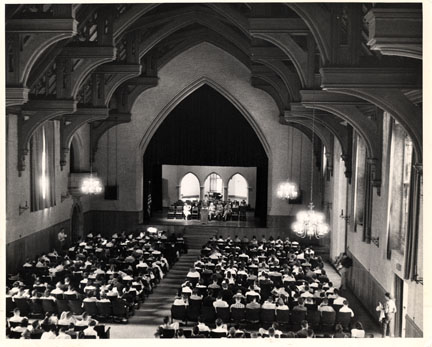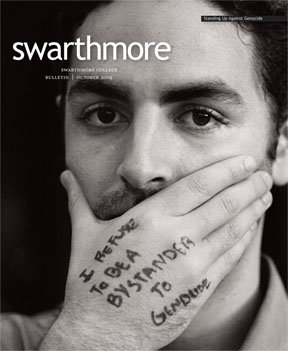First There Was Collection—Now There’s First Collection

In the late 1940s, campus life included a weekly mandatory Collection, held in Clothier Hall. Students were seated alphabetically, so that absences could be easily noted.
On Aug. 26, members of the Class of 2013 gathered at dusk in the Scott Amphitheater for an assembly that has become a rite of initiation for all Swarthmore freshmen for the past 15 years—the First Collection.
First Collection in its current form was introduced in 1994 by Andrew Feldman ’96, now senior policy adviser in the office of Wisconsin Governor Jim Doyle. As the student leader of freshman orientation, Feldman borrowed the idea of passing candlelight from an event he had experienced earlier as a camp counselor. With the support of then-Dean for Student Life Tedd Goundie—who told Feldman, “I’ll support you on this, but please don’t burn the school down”—Feldman designed the ceremony that has become a fully-fledged tradition.
“Swarthmore students can take their own meaning from the candle-lighting ceremony that concludes First Collection,” Feldman says. “To me, the candles are a symbol of solidarity among the incoming class, but also a symbolic reference to the College’s Quaker roots—to the concept of ‘inner light,’—and the unique set of beliefs that each individual brings to the College.”
Although passing of candlelight at First Collection is relatively new, the notion of “Collection” at Swarthmore is decades old. According to Christopher Densmore, curator of Friends Historical Library, the Annual Catalog of 1870–1871 mentions a form of assembly at the end of each day for worship, at which readings from Scripture were followed by a period of silence. Later catalog entries mention daily meetings for religious exercises and the “imparting of moral lessons as circumstances seem to require.”
By 1933, these assemblies took place at 9 a.m., Monday through Friday. A “Collection” was held every Wednesday in Clothier Memorial Hall. This 15-minute meeting, at which student attendance was required,
comprised speakers and music, preceded by a period of silence in accordance with Quaker practice. On Mondays, Wednesdays, and Fridays, a voluntary collection occurred in Friends Meeting House.
The 1949 catalog, under the heading “Religious Life,” described a weekly mandatory Collection at 10 a.m. every Thursday in Clothier Hall, which lasted from “one-half to three-quarters of an hour and included occasional musical, dramatic, and other programs.”
Vice President for College and Community Relations and Executive Assistant to the President Maurice Eldridge ’61 recalls “almost weekly meetings that we had to attend. There was always a speaker. Sometimes, someone would come up with a prank in an attempt to disturb the meeting, bringing in chickens or cows, and there was quite a lot of reading of The New York Times.”
By 1970–1971, the traditional gatherings had been cut back to three times a semester. The length and style of the program remained the same, but attendance was no longer mandatory. A year later, the catalog referred to a Collection that was “held at a regular hour several times a term for addresses or special events. Attendance is voluntary.” It went on to say that “in 1971–1972, a series of talks by College faculty members on topics in their fields of professional interest and from their own work … is planned as the principal focus of Collection…. The president will address the first Collection each semester, and there will be an opportunity in each semester for programs sponsored by the Student Council.” No reference was made to any type of religious exercises at these later meetings.
Currently, all-campus meetings, still called Collections, occasionally occur at no fixed intervals, taking the form of meetings to discuss current issues relevant to the whole College community. Attendance is voluntary.
 Email This Page
Email This Page